AWM137 2/1 - Historical information and general development of the RAAF Nursing Service - Notes of History of the RAAF Nursing Service 1940-1944 - Part 13
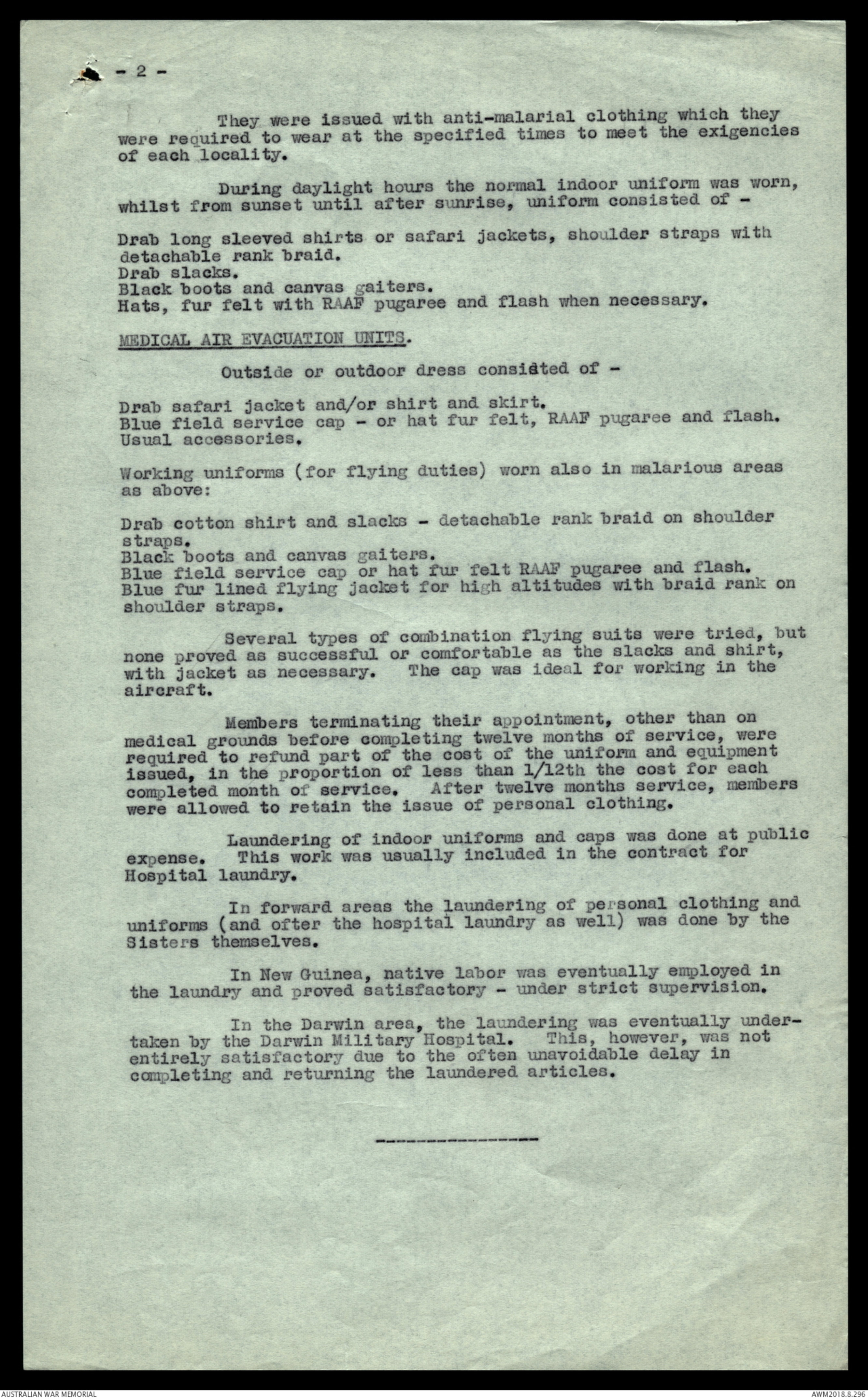
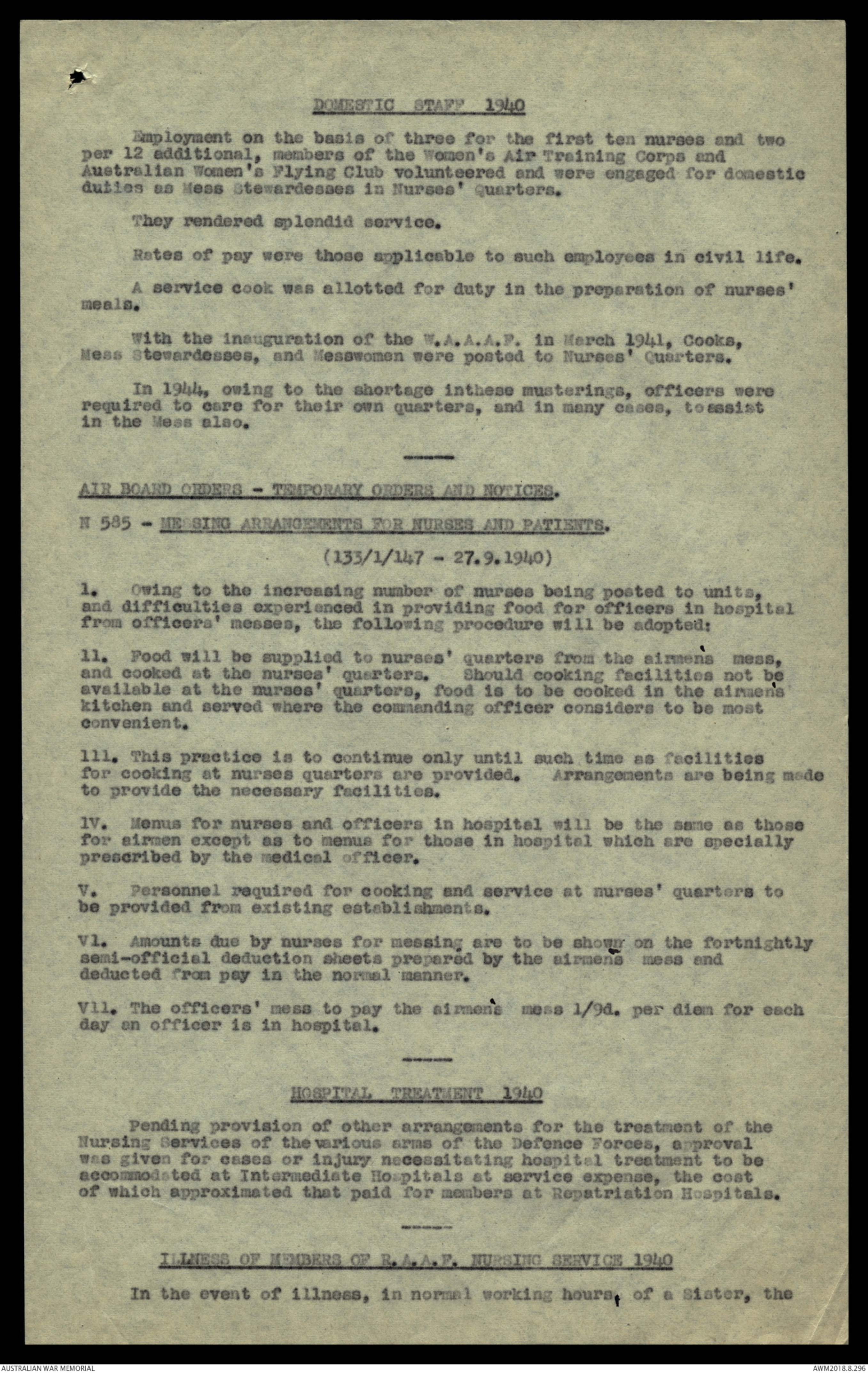
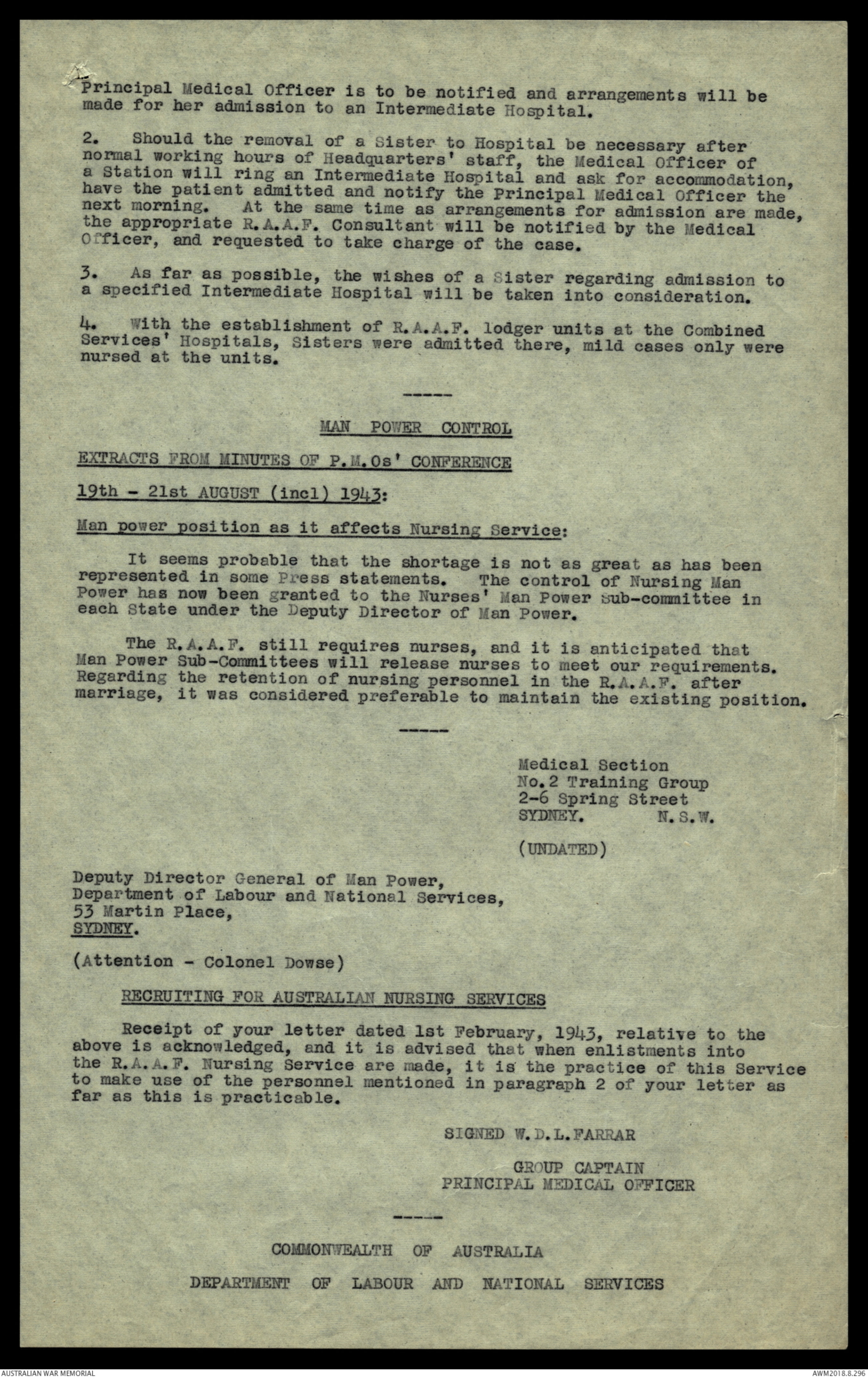

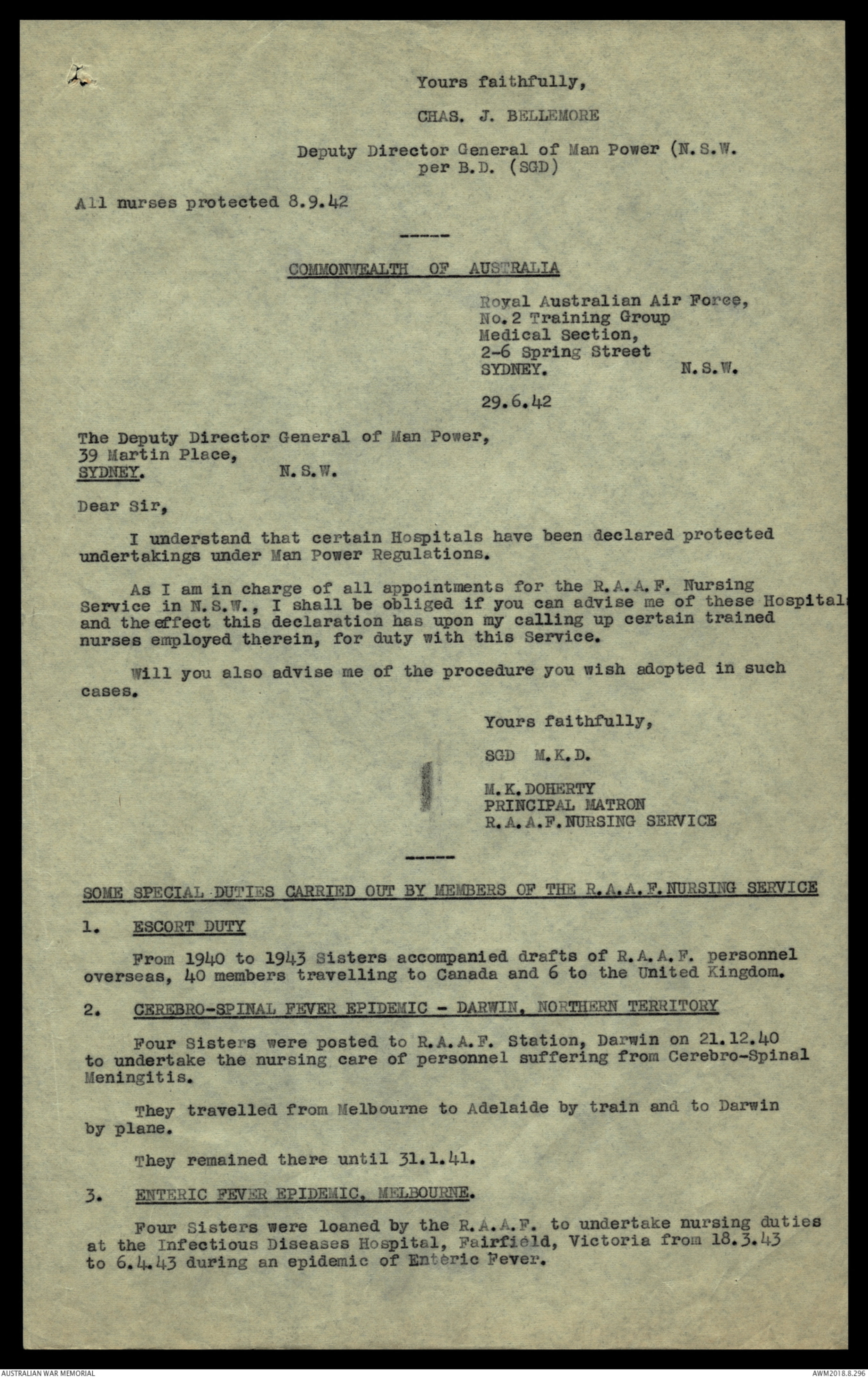
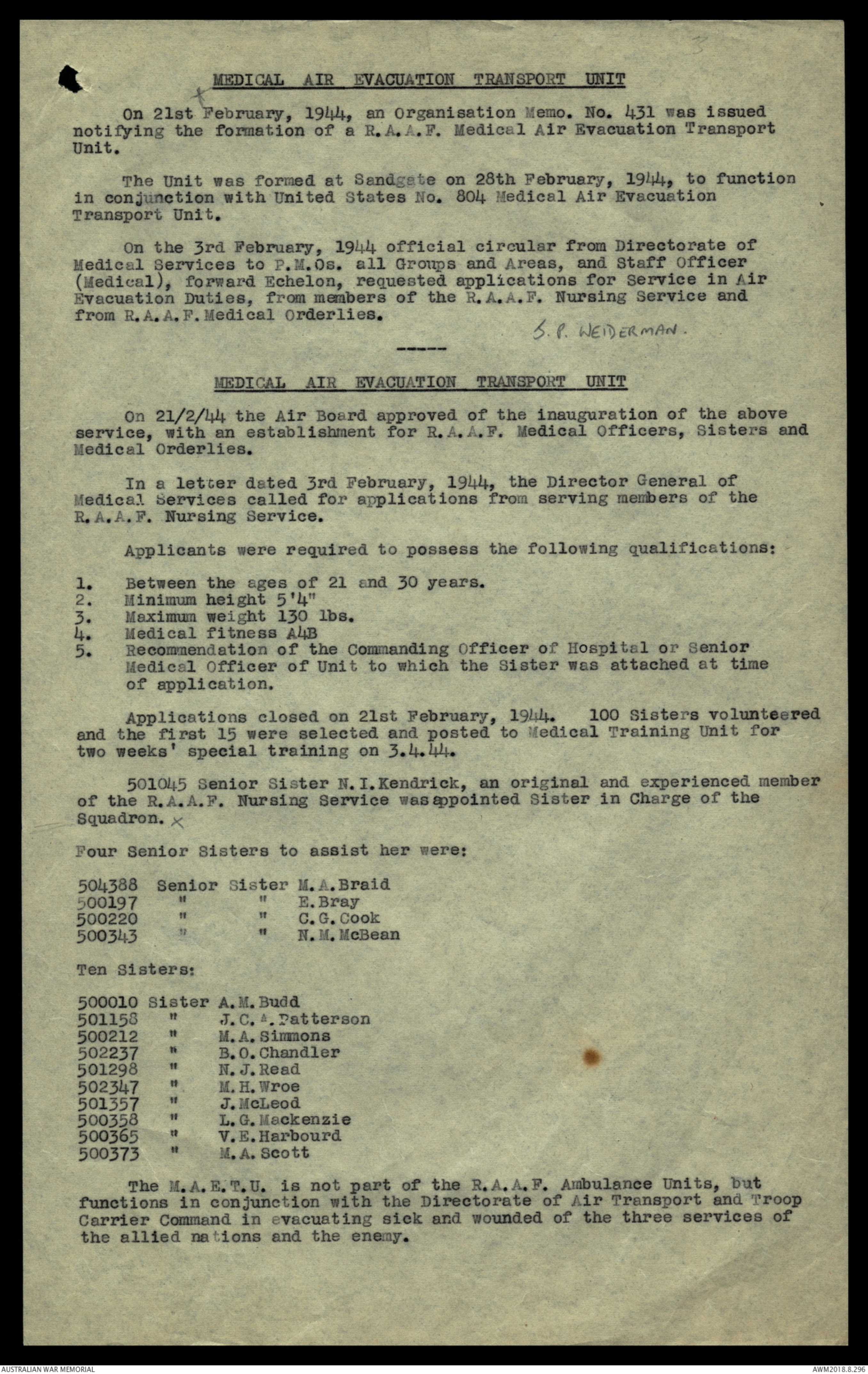
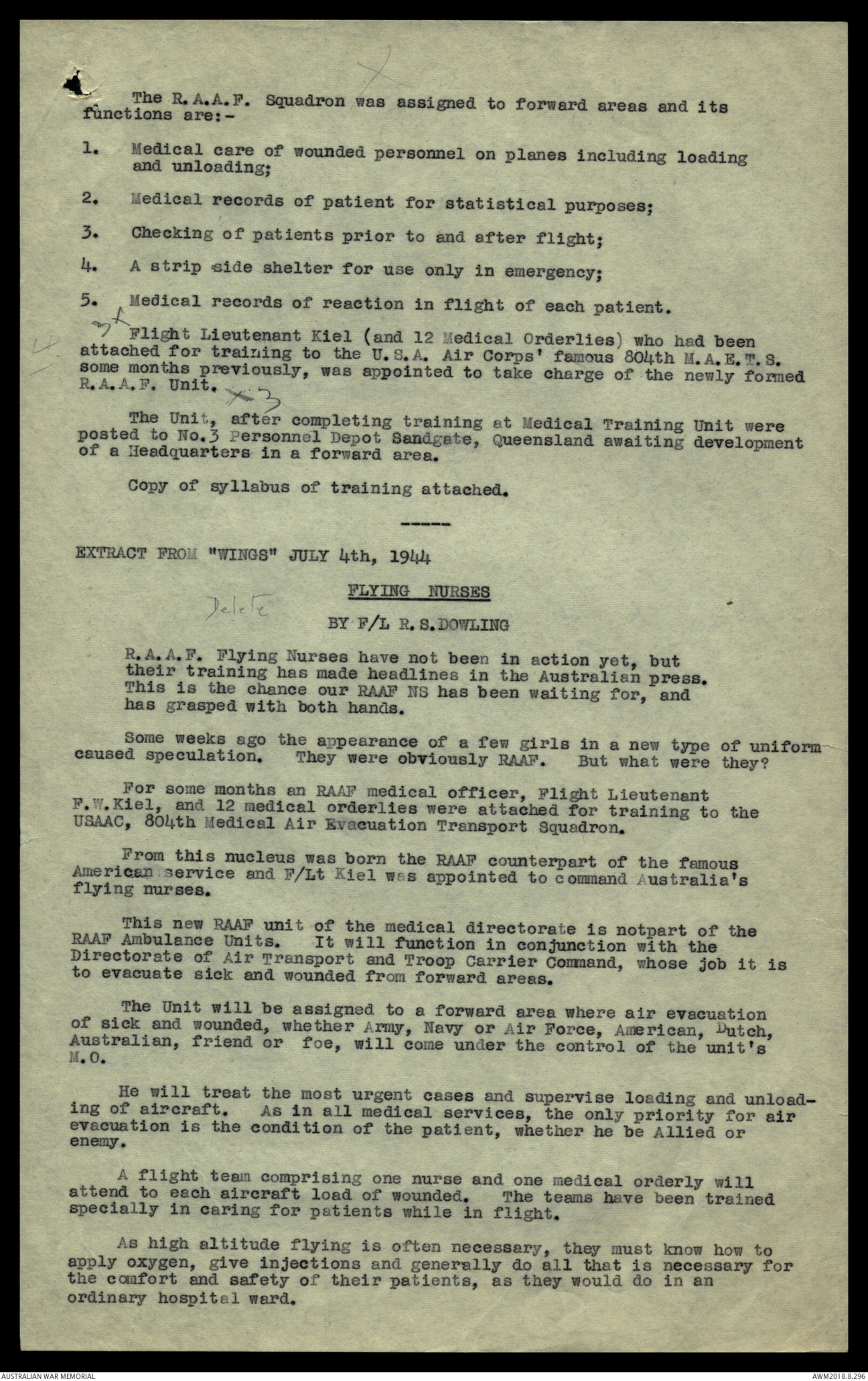
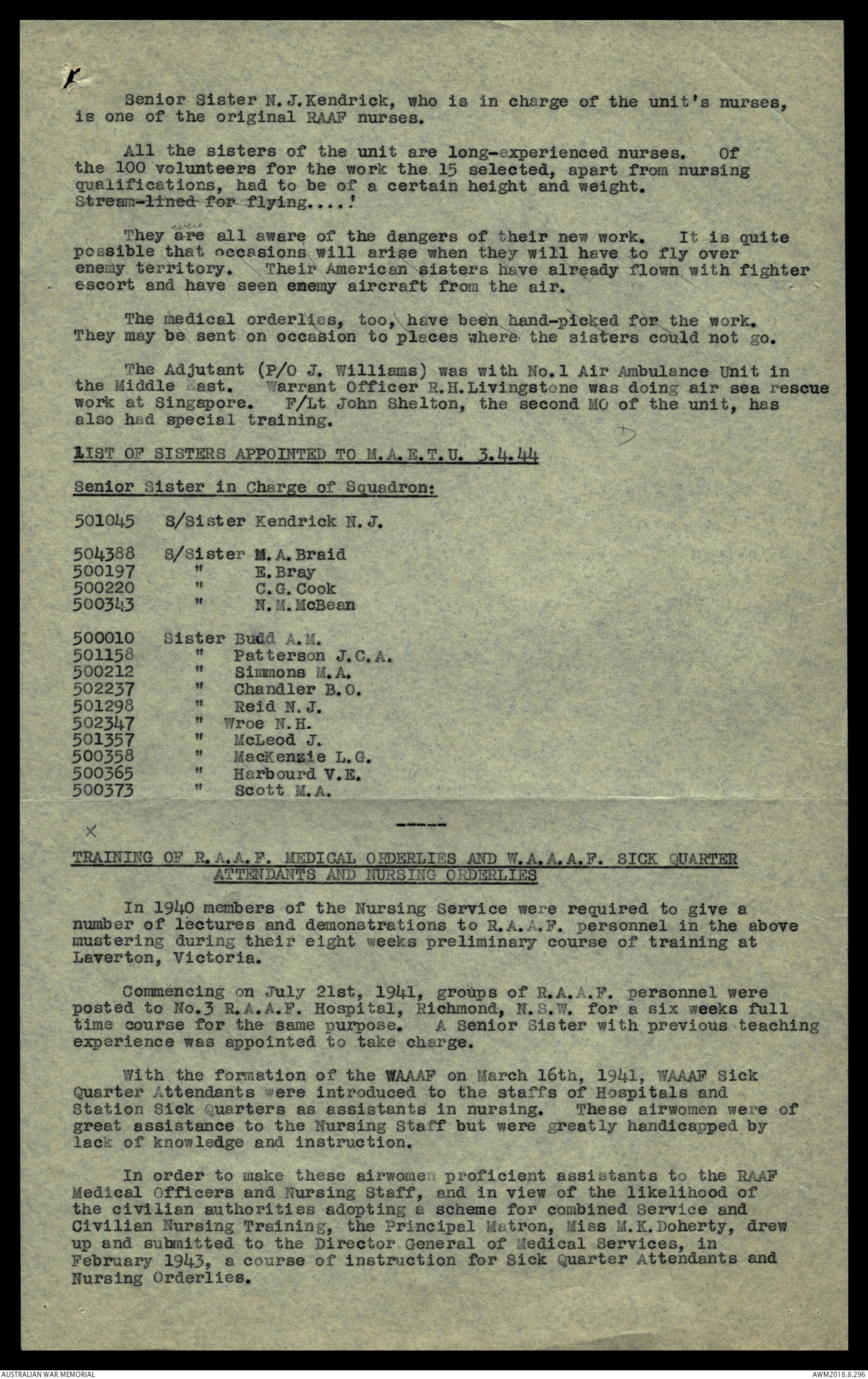
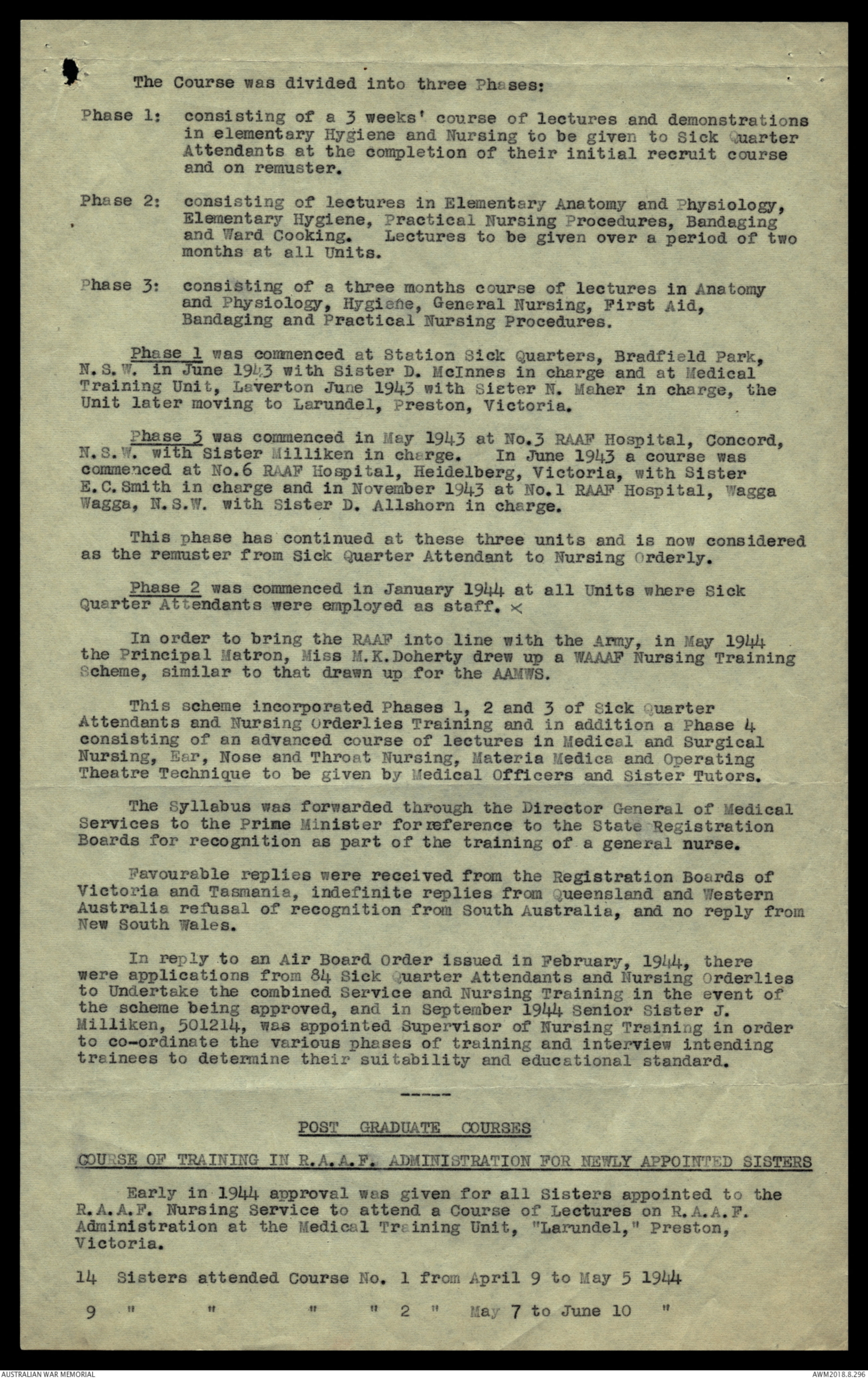
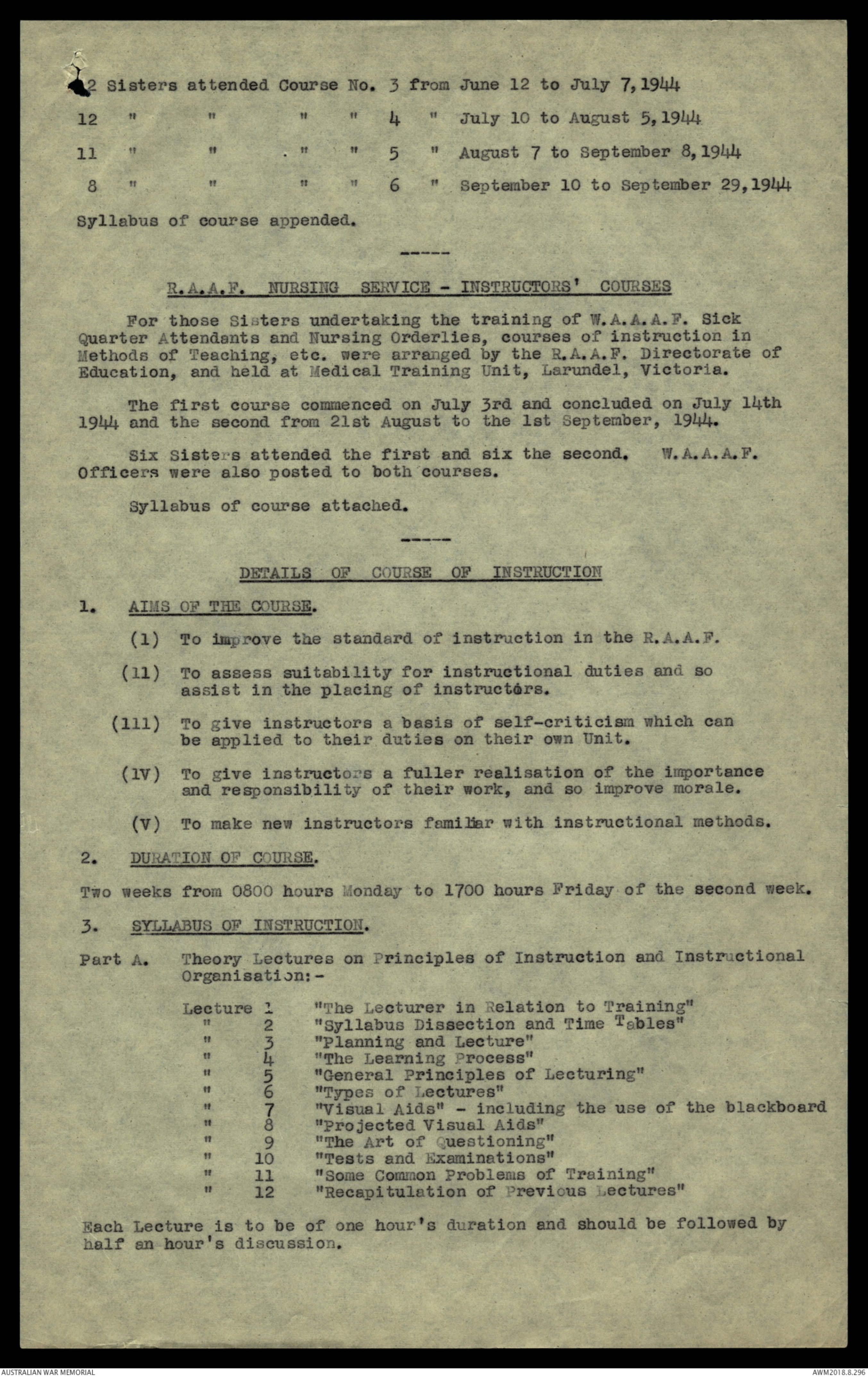
- 2 -
They were issued with anti-malarial clothing which they
were required to wear at the specified times to meet the exigencies
of each locality.
During daylight hours the normal indoor uniform was worn,
whilst from sunset until after sunrise, uniform consisted of -
Drab long sleeved shirts or safari jackets, shoulder straps with
detachable rank braid.
Drab slacks.
Black boots and canvas gaiters.
Hats, fur felt with RAAF pugaree and flash when necessary.
MEDICAL AIR EVACUATION UNITS.
Outside or outdoor dress consisted of -
Drab safari jacket and/or shirt and skirt.
Blue field service cap - or hat fur felt, RAAF pugaree and flash.
Usual accessories.
Working uniforms (for flying duties) worn also in malarious areas
as above:
Drab cotton shirt and slacks - detachable rank braid on shoulder
straps.
Black boots and canvas gaiters.
Blue field service cap or hat fur felt RAAF pugaree and flash.
Blue fur lined flying jacket for high altitudes with braid rank on
shoulder straps.
Several types of combination flying suits were tried, but
none proved as successful or comfortable as the slacks and shirt,
with jacket as necessary. The cap was ideal for working in the
aircraft.
Members terminating their appointment, other than on
medical grounds before completing twelve months of service, were
required to refund part of the cost of the uniform and equipment
issued, in the proportion of less than 1/12th the cost for each
completed month of service. After twelve months service, members
were allowed to retain the issue of personal clothing.
Laundering of indoor uniforms and caps was done at public
expense. This work was usually included in the contract for
Hospital laundry.
In forward areas the laundering of personal clothing and
uniforms (and ofter the hospital laundry as well) was done by the
Sisters themselves.
In New Guinea, native labor was eventually employed in
the laundry and proved satisfactory - under strict supervision.
In the Darwin area, the laundering was eventually undertaken
by the Darwin Military Hospital. This, however, was not
entirely satisfactory due to the often unavoidable delay in
completing and returning the laundered articles.
DOMESTIC STAFF 1940
Employment on the basis of three for the first ten nurses and two
per 12 additional, members of the Women's Air Training Corps and
Australian Women's Flying Club volunteered and were engaged for domestic
duties as Mess Stewardesses in Nurses’ Quarters.
They rendered splendid service.
Rates of pay were those applicable to such employees in civil life.
A service cook was allotted for duty in the preparation of nurses'
meals.
With the inauguration of the W.A.A.A.F. in March 1941, Cooks,
Mess Stewardesses, and Messwomen were posted to Nurses‘ Quarters.
In 1944, owing to the shortage inthese musterings, officers were
required to care for their own quarters, and in many cases, to assist
in the Mess also. .
AIR BOARD ORDERS - TEMPORARY ORDERS AND NOTICES.
N 585 - MESSING ARRANGEMENTS FOR NURSES AND PATIENTS.
(133/1/147 - 27.9.1940)
1. Owing to the increasing number of nurses being posted to units,
and difficulties experienced in providing food for officers in hospital
from officers' messes, the following procedure will be adopted:
11. Food will be supplied to nurses' quarters from the airmen's mess,
and cooked at the nurses' quarters. Should cooking facilities not be
available at the nurses' quarters, food is to be cooked in the airmen's
kitchen and served where the commanding officer considers to be most
convenient.
111. This practice is to continue only until such time as facilities
for cooking at nurses quarters are provided. Arrangements are being made
to provide the necessary facilities.
1V. Menus for nurses and officers in hospital will be the same as those
for airmen except as to menus for those in hospital which are specially
prescribed by the medical officer.
V. Personnel required for cooking and service at nurses’ quarters to
be provided from existing establishments.
V1. Amounts due by nurses for messing are to be shown on the fortnightly
semi-official deduction sheets prepared by the airmen's mess and
deducted from pay in the normal manner.
V11. The officers‘ mess to pay the airmen's mess 1/9d. per diem for each
day an officer is in hospital.
HOSPITAL TREATMENT 1940
Pending provision of other arrangements for the treatment of the
Nursing Services of the various arms of the Defence Forces, approval
was given for cases or injury necessitating hospital treatment to be
accommodated at Intermediate Hospitals at service expense, the cost
of which approximated that paid for members at Repatriation Hospitals.
ILLNESS OF MEMBERS OF R.A.A.F. NURSING SERVICE 1940
In the event of illness, in normal working hours, of a Sister, the
Principal Medical Officer is to be notified and arrangements will be
made for her admission to an Intermediate Hospital.
2. Should the removal of a Sister to Hospital be necessary after
normal working hours of Headquarters’ staff, the Medical Officer of
a Station will ring an Intermediate Hospital and ask for accommodation,
have the patient admitted and notify the Principal Medical Officer the
next morning. At the same time as arrangements for admission are made,
the appropriate R.A.A.F. Consultant will be notified by the Medical
Officer, and requested to take charge of the case.
3. As far as possible, the wishes of a Sister regarding admission to
a specified Intermediate Hospital will be taken into consideration.
4. With the establishment of R.A.A.F. lodger units at the Combined
Services’ Hospitals, Sisters were admitted there, mild cases only were
nursed at the units.
MAN POWER CONTROL
EXTRACTS FROM MINUTES OF P.M.Os' CONFERENCE
19th - 21st AUGUST (incl) 1943:
Man power position as it affects Nursing Service:
It seems probable that the shortage is not as great as has been
represented in some Press statements. The control of Nursing Man
Power has now been granted to the Nurses’ Man Power Sub-committee in
each State under the Deputy Director of Man Power.
The R.A.A.F. still requires nurses, and it is anticipated that
Man Power Sub-Committees will release nurses to meet our requirements.
Regarding the retention of nursing personnel in the R.A.A.F. after
marriage, it was considered preferable to maintain the existing position.
Medical Section
No.2 Training Group
2-6 Spring Street
SYDNEY. N. S. W.
(UNDATED)
Deputy Director General of Man Power,
Department of Labour and National Services,
53 Martin Place,
SYDNEY.
(Attention - Colonel Dowse)
RECRUITING FOR AUSTRALIAN NURSING SERVICE
Receipt of your letter dated 1st February, 1943, relative to the
above is acknowledged, and it is advised that when enlistments into
the R.A.A.F. Nursing Service are made, it is the practice of this Service
to make use of the personnel mentioned in paragraph 2 of your letter as
far as this is practicable.
SIGNED W. D. L. FARRAR
GROUP CAPTAIN
PRINCIPAL MEDICAL OFFICER
COMMONWEALTH OF AUSTRALIA
DEPARTMENT OF LABOUR AND NATIONAL SERVICES
Office of the Deputy Director General of Man Power (N.S.W.)
A.P.A. Building,
53 Martin Place,
SYDNEY.
1st February, 1943.
Principal Medical Officer,
No.2 Training Group, Medical Section, R.A.A.F.,
2-6 Spring Street,
SYDNEY.
RECRUITING FOR AUSTRALIAN NURSING SERVICES
In view of the parlous position of hospitals, particularly public
hospitals, resulting from the scarcity of nurses, it is not proposed,
except in very exceptional circumstances, to release nurses from positions
in public and private hospitals for enrolment in the Armed Forces even
though particular hospital authorities express willingness to allow
personnel to resign for this purpose.
Every endeavour should therefore be made to enrol nurses for the
services from among those in private practice or those who had not been
employed in public or private hospitals for at least six months prior to
their date of application for enlistment.
Consideration, however, will be given to the release of nurses who
have just completed training in public hospitals if they desire to be
enrolled.
Correspondence concerning these matters should be addressed to me
from the Forces and marked "Attention Colonel Dowse."
C. J. BELLEMORE
Deputy Director General of Man Power, N.S.W.
per R.D. (SGD)
DEPARTMENT OF LABOUR AND NATIONAL SERVICES
Office of the Deputy Director General of Man Power (N.S.W.)
A.P.A. Building,
53 Martin Place,
SYDNEY.
10th July, l942.
ERP/BD 25978
The Principal Matron,
R.A.A.F.Nursing Service,
2-6 Spring Street,
SYDNEY.
Dear Matron,
I refer to your letter of the 29th ultimo and have to inform you
that all Public Hospitals in the State of New South have been
declared "protected undertakings” under the provisions of the National
Security (Man Power) Regulations. No private hospitals are covered by
this protection.
Reg. 14 of the abovementioned Regulations provides that no employee
in a "protected undertaking" can be appointed to or enlisted in the
Defence Forces without my permission.
It is not usual to give this permission if the employer does not
approve of the employee leaving.
It is suggested that arrangements be made for the nurses whom you
desire to call-up for duty with the R.A.A.F. Nursing Service to produce
to this office or the National Service Officer for the Military area in
which they reside evidence of the approval of the hospital to whose
staff they are attached to their enlistment.
The issue of the clearance required by the abovementioned section
will then be facilitated.
Yours faithfully,
CHAS. J. BELLEMORE
Deputy Director General of Man Power (N.S.W.
per B.D. (SGD)
All nurses protected 8.9.42
COMMONWEALTH OF AUSTRALIA
Royal Australian Air Force,
No.2 Training Group
Medical Section,
2-6 Spring Street
SYDNEY. N. S. W.
29.6.42
The Deputy Director General of Man Power,
39 Martin Place,
SYDNEY. N. S. W.
Dear Sir,
I understand that certain Hospitals have been declared protected
undertakings under Man Power Regulations.
As I am in charge or all appointments for the R.A.A.F. Nursing
Service in N.S.W., I shall be obliged if you can advise me of these Hospitals
and the effect this declaration has upon my calling up certain trained
nurses employed therein, for duty with this Service.
Will you also advise me of the procedure you wish adopted in such
cases.
Yours faithfully,
SGD M.K.D.
M. K. DOHERTY
PRINCIPAL MATRON
R.A.A.F. NURSING SERVICE
SOME SPECIAL DUTIES CARRIED OUT BY MEMBERS OF THE R.A.A.F. NURSING SERVICE
1. ESCORT DUTY
From 1940 to 1943 Sisters accompanied drafts of R.A.A.F. personnel
overseas, 40 members travelling to Canada and 6 to the United Kingdom.
2. CEREBRO-SPINAL FEVER EPIDEMIC — DARWIN, NORTHERN TERRITORY
Four Sisters were posted to R.A.A.F. Station, Darwin on 21.12.40
to undertake the nursing care of personnel suffering from Cerebro-Spinal
Meningitis.
They travelled from Melbourne to Adelaide by train and to Darwin
by plane.
They remained there until 31.1.41.
3. ENTERIC FEVER EPIDEMIC, MELBOURNE
Four Sisters were loaned by the R.A.A.F. to undertake nursing duties
at the Infectious Diseases Hospital, Fairfield, Victoria from 18.3.43
to 6.4.43 during an epidemic of Enteric Fever.
MEDICAL AIR EVACUATION TRANSPORT UNIT
On 21st February, 1944, an organisation Memo. No. 431 was issued
notifying the formation of a R.A.A.F. Medical Air Evacuation Transport
Unit.
The Unit was formed at Sandgate on 28th February, 1944, to function
in conjunction with United States No. 804 Medical Air Evacuation
Transport Unit.
On the 3rd February, 1944 official circular from Directorate of
Medical Services to P.M.Os. all Groups and Areas, and Staff Officer
(Medical), forward Echelon, requested applications for Service in Air
Evacuation Duties, from members of the R.A.A.F. Nursing Service and
from R.A.A.F. Medical Orderlies.
J. P. WEIDERMAN.
MEDICAL AIR EVACUATION TRANSPORT UNIT
On 21/2/44 the Air Board approved of the inauguration of the above
service, with an establishment for R.A.A.F. Medical Officers, Sisters and
Medical Orderlies.
In a letter dated 3rd February, 1944, the Director General of
Medical Services called for applications from serving members of the
R.A.A.F. Nursing Service.
Applicants were required to possess the following qualifications:
1. Between the ages of 21 and 30 years.
2. Minimum height 5' 4"
3. Maximum weight 130 lbs.
4. Medical fitness A4B
5. Recommendation of the Commanding Officer of Hospital or Senior
Medical Officer of Unit to which the Sister was attached at time
of application.
Applications closed on 21st February, 1944. 100 Sisters volunteered
and the first 15 were selected and posted to Medical Training Unit for
two weeks‘ special training on 3.4.44.
501045 Senior Sister N. I. Kendrick, an original and experienced member
of the R.A.A.F. Nursing Service was appointed Sister in Charge of the
Squadron. x
Four Senior Sisters to assist her were:
504388 Senior Sister M. A. Braid
500197 " " E. Bray
500220 " " C. G. Cook
500343 " " N. M. McBean
Ten Sisters:
500010 Sister A. M. Budd
501158 " J. C. A. Patterson
500212 " M. A. Simmons
502237 " B. O. Chandler
501298 " N. J. Read
502347 " M. H. Wroe
501357 " J. McLeod
500358 " L. G. Mackenzie
500365 " V. E. Harbourd
500373 " M. A. Scott
The M.A.E.T.U. is not part of the R.A.A.F. Ambulance Units, but
functions in conjunction with the Directorate of Air Transport and Troop
Carrier Command in evacuating sick and wounded of the three services of
the allied nations and the enemy.
The R.A.A.F. Squadron was assigned to forward areas and its
functions are:-
1. Medical care of wounded personnel on planes including loading
and unloading;
2. Medical records of patient for statistical purposes;
3. Checking of patients prior to and after flight;
4. A strip side shelter for use only in emergency;
5. Medical records of reaction in flight of each patient.
3 x
Flight Lieutenant Kiel (and 12 Medical Orderlies) who had been
attached for training to the U.S.A. Air Corps’ famous 804th M.A.E.T.S.
some months previously, was appointed to take charge of the newly formed
R.A.A.F. Unit. x3
The Unit, after completing training at Medical Training Unit were
posted to No.3 Personnel Depot Sandgate, Queensland awaiting development
of a Headquarters in a forward area.
Copy of syllabus of training attached.
EXTRACT FROM "WINGS" JULY 4th, 1944
[*Delete*] FLYING NURSES
BY F/L R. S. DOWLING
R.A.A.F. Flying Nurses have not been in action yet, but
their training has made headlines in the Australian press.
This is the chance our RAAF NS has been waiting for, and
has grasped with both hands.
Some weeks ago the appearance of a few girls in a new type of uniform
caused speculation. They were obviously RAAF. But what were they?
For some months an RAAF medical officer, Flight Lieutenant
F. W. Kiel, and 12 medical orderlies were attached for training to the
USAAC, 804th Medical Air Evacuation Transport Squadron.
From this nucleus was born the RAAF counterpart of the famous
American service and F/Lt Kiel was appointed to command Australia's
flying nurses.
This new RAAF unit of the medical directorate is notpart of the
RAAF Ambulance Units. It will function in conjunction with the
Directorate of Air Transport and Troop Carrier Command, whose job it is
to evacuate sick and wounded from forward areas.
The Unit will be assigned to a forward area where air evacuation
of sick and wounded, whether Army, Navy or Air Force, American, Dutch,
Australian, friend or foe, will come under the control of the unit's
M.O.
He will treat the most urgent cases and supervise loading and unloading
of aircraft. As in all medical services, the only priority for air
evacuation is the condition of the patient, whether he be Allied or
enemy.
A flight team comprising one nurse and one medical orderly will
attend to each aircraft load of wounded. The teams have been trained
specially in caring for patients while in flight.
As high altitude flying is often necessary, they must know how to
apply oxygen, give injections and generally do all that is necessary for
the comfort and safety of their patients, as they would do in an
ordinary hospital ward.
Senior Sister N.J. Kendrick, who is in charge of the unit's nurses,
is one of the original RAAF nurses.
All the sisters of the unit are long-experienced nurses. Of
the 100 volunteers for the work the 15 selected, apart from nursing
qualifications, had to be of a certain height and weight.
Stream-lined for flying....!
They are were all aware of the dangers of their new work. It is quite
possible that occasions will arise when they will have to fly over
enemy territory. Their American sisters have already flown with fighter
escort and have seen enemy aircraft from the air.
The medical orderlies, too, have been hand-picked for the work.
They may be sent on occasion to places where the sisters could not go.
The Adjutant (P/O J. Williams) was with No. 1 Air Ambulance Unit in
the Middle East. Warrant Officer R.H. Livingstone was doing air sea rescue
work at Singapore. F/Lt John Shelton, the second MO of the unit, has
also had special training.
LIST OF SISTERS APPOINTED TO M.A.E.T.U. 3.4.44
Senior Sister in Charge of Squadron:
501045 S/Sister Kendrick N. J.
504388 S/Sister M. A. Braid
500197 " E. Bray
500220 " C. G Cook
500343 " N. M. McBean
500010 Sister Budd A. M.
501158 " Patterson J. C. A.
500212 " Simmons M. A.
502237 " Chandler B. O.
501298 " Reid N. J.
502347 " Wroe N. H.
501357 " McLeod J.
500358 " MacKenzie L. G.
500365 " Harbourd V. E.
500373 " Scott M. A.
x
TRAINING OF R.A.A.F. MEDICAL ORDERLIES AND W.A.A.A.F. SICK QUARTER
ATTENDANTS AND NURSING ORDERLIES
In 1940 members of the Nursing Service were required to give a
number of lectures and demonstrations to R.A.A.F personnel in the above
mustering during their eight weeks preliminary course of training at
Laverton, Victoria.
Commencing on July 21st, 1941, groups of R.A.A.F. personnel were
posted to No.3 R.A.A.F. Hospital, Richmond, N.S.W. for a six weeks full
time course for the same purpose. A Senior Sister with previous teaching
experience was appointed to take charge.
With the formation of the WAAAF on March 16th, 1941, WAAAF Sick
Quarter Attendants were introduced to the staffs of Hospitals and
Station Sick Quarters as assistants in nursing. These airwomen were of
great assistance to the Nursing Staff but were greatly handicapped by
lack of knowledge and instruction.
In order to make these airwomen proficient assistants to the RAAF
Medical Officers and Nursing Staff, and in view of the likelihood of
the civilian authorities adopting a scheme for combined Service and
Civilian Nursing Training, the Principal Matron, Miss M.K. Doherty, drew
up and submitted to the Director General of Medical Services, in
February 1943, a course of instruction for Sick Quarter Attendants and
Nursing Orderlies.
The Course was divided into three Phases:
Phase 1: consisting of a 3 weeks' course of lectures and demonstrations
in elementary Hygiene and Nursing to be given to Sick Quarter
Attendants at the completion of their initial recruit course
and on remuster.
Phase 2: consisting of lectures in Elementary Anatomy and Physiology,
Elementary Hygiene, Practical Nursing Procedures, Bandaging
and Ward Cooking. Lectures to be given over a period of two
months at all Units.
Phase 3: consisting of a three months course of lectures in Anatomy
and Physiology, Hygiene, General Nursing, First Aid,
Bandaging and Practical Nursing Procedures.
Phase 1 was commenced at Station Sick Quarters, Bradfield Park,
N.S.W. in June 1943 with Sister D. McInnes in charge and at Medical
Training Unit, Laverton June 1943 with Sister N. Maher in charge, the
Unit later moving to Larundel, Preston, Victoria.
Phase 3 was commenced in May 1943 at No.3 RAAF Hospital, Concord,
N.S.W. with Sister Milliken in charge. In June 1943 a course was
commenced at No. 6 RAAF Hospital, Heidelberg, Victoria, with Sister
E.C. Smith in charge and in November 1943 at No. 1 RAAF Hospital, Wagga
Wagga, N.S.W. with Sister D. Allshorn in charge.
This phase has continued at these three units and is now considered
as the remuster from Sick Quarter Attendant to Nursing Orderly.
Phase 2 was commenced in January 1944 at all Units where Sick
Quarter Attendants were employed as staff. x
In order to bring the RAAF into line with the Army, in May 1944
the Principal Matron, Miss M.K. Doherty drew up a WAAAF Nursing Training
Scheme, similar to that drawn up for the AAMWS.
This scheme incorporated Phases 1, 2 and 3 of Sick Quarter
Attendants and Nursing Orderlies Training and in addition a Phase 4
consisting of an advanced course of lectures in Medical and Surgical
Nursing, Ear, Nose, and Throat Nursing, Materia Medica and Operating
Theatre Technique to be given by Medical Officers and Sister Tutors.
The Syllabus was forwarded through the Director General of Medical
Services to the Prime Minister for reference to the State Registration
Boards for recognition as part of the training of a general nurse.
Favourable replies were received from the Registrations Boards of
Victoria and Tasmania, indefinite replies from Queensland and Western
Australia refusal of recognition from South Australia, and no reply from
New South Wales.
In reply to an Air Board Order issued in February, 1944, there
were applications from 84 Sick Quarter Attendants and Nursing Orderlies
to Undertake the combined Service and Nursing Training in the event of
the scheme being approved, and in September 1944 Senior Sister J.
Milliken, 501214, was appointed Supervisor of Nursing Training in order
to co-ordinate the various phases of training and interview intending
trainees to determine their suitability and educational standard.
POST GRADUATE COURSES
COURSE OF TRAINING IN R.A.A.F. ADMINISTRATION FOR NEWLY APPOINTED SISTERS
Early in 1944 approval was given for all Sisters appointed to the
R.A.A.F. Nursing Service to attend a Course of Lectures on R.A.A.F.
Administration at the Medical Training Unit, "Larundel," Preston,
Victoria.
14 Sisters attended Course No. 1 from April 9 to May 5 1944
9 " " " " 2 " May 7 to June 10 "
2 Sisters attended Course No. 3 from June 12 to July 7, 1944
12 " " " " 4 " July 10 to August 5, 1944
11 " " " " 5 " August 7 to September 8, 1944
8 " " " " 6 " September 10 to September 29, 1944
Syllabus of course appended.
R.A.A.F. NURSING SERVICE - INSTRUCTORS' COURSES
For those Sisters undertaking the training of W.A.A.A.F. Sick
Quarter Attendants and Nursing Orderlies, courses of instruction in
Methods of Teaching, etc. were arranged by the R.A.A.F. Directorate of
Education, and held at Medical Training Unit, Larundel, Victoria.
The first course commenced on July 3rd and concluded on July 14th
1944 and the second from 21st August to the 1st September, 1944.
Six Sisters attended the first and six the second. W.A.A.A.F.
Officers were also posted to both courses.
Syllabus of course attached.
DETAILS OF COURSE OF INSTRUCTION
1. AIMS OF THE COURSE.
(1) To improve the standard of instruction in the R.A.A.F.
(11) To assess suitability for instructional duties and so
assist in the placing of instructors.
(111) To give instructors a basis of self-criticism which can
be applied to their duties on their own Unit.
(1V) To give instructors a fuller realisation of the importance
and responsibility of their work, and so improve morale.
(V) To make new instructors familiar with instructional methods.
2. DURATION OF COURSE.
Two weeks from 0800 hours Monday to 1700 hours Friday of the second week.
3. SYLLABUS OF INSTRUCTION.
Part A. Theory Lectures on Principles of Instruction and Instructional
Organisation: -
Lecture 1 "The Lecturer in Relation to Training"
" 2 "Syllabus Dissection and Time Tables"
" 3 "Planning and Lecture"
" 4 "The Learning Process"
" 5 "General Principles of Lecturing"
" 6 "Types of Lectures"
" 7 "Visual Aids" - including the use of the blackboard
" 8 "Projected Visual Aids"
" 9 "The Art of Questioning"
" 10 "Tests and Examinations"
" 11 "Some Common Problems of Training"
" 12 "Recapitulation of Previous Lectures"
Each Lecture is to be of one hour's duration and should be followed by
half an hour's discussion.
 Kerian
KerianThis transcription item is now locked to you for editing. To release the lock either Save your changes or Cancel.
This lock will be automatically released after 60 minutes of inactivity.